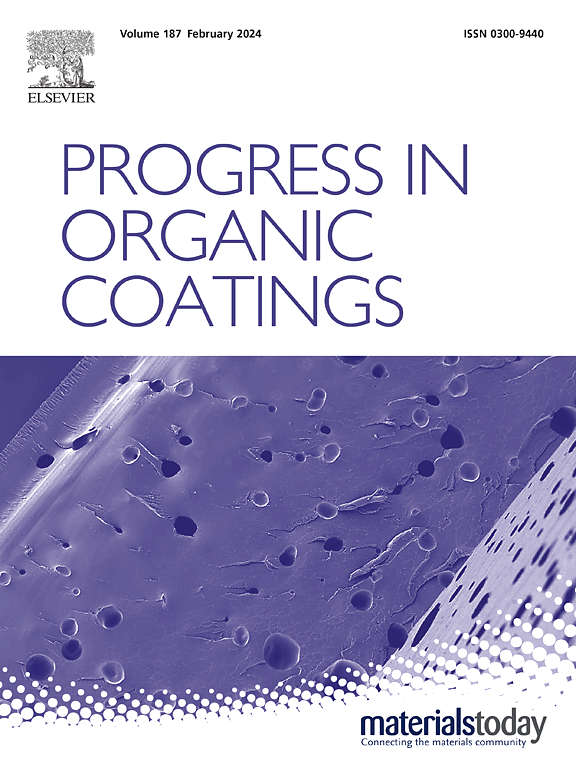Investigate the performance of functional coatings with physically modified boron nitride composite fillers
IF 6.5
2区 材料科学
Q1 CHEMISTRY, APPLIED
引用次数: 0
Abstract
Fillers play a pivotal role in endowing coatings with multifunctional properties. Hexagonal boron nitride (h-BN), a lamellar nanofiller, can significantly enhance the thermal conductivity, corrosion resistance, and mechanical properties of polymer resin-based coatings due to its unique structural features. However, the significant surface energy mismatch between h-BN (a low-polarity inorganic material) and polar organic polymers leads to poor interfacial wettability and phase separation tendencies. Simultaneously, the high specific surface area of BN nano/micro particles promotes agglomeration driven by hydrogen bonding, π-π stacking, or electrostatic forces (e.g., charged surfaces). This study employs an environmentally friendly physical encapsulation strategy to modify h-BN using silica sol, while leveraging the porous structure of dried silica sol to adsorb the corrosion inhibitor benzotriazole (BTA), thereby synergistically improving the corrosion resistance of the coating. FE-SEM observations confirm that silica sol successfully constructs a porous morphology on the surface of lamellar BN, effectively inhibiting filler agglomeration in the resin. The introduction of modified BN increases the coating hardness to 3H, with in-plane and through-thickness thermal conductivities improving by 1332 % and 342 %, respectively, compared to pure epoxy coatings. Electrochemical impedance spectroscopy (EIS) and salt spray tests demonstrate a remarkable enhancement in corrosion resistance. This research provides a novel approach for the application of h-BN in functional protective coatings.
研究使用物理改性氮化硼复合填料的功能涂料的性能
填料在赋予涂料多功能性能方面起着关键作用。六方氮化硼(h-BN)是一种层状纳米填料,由于其独特的结构特点,可以显著提高聚合物树脂基涂层的导热性、耐腐蚀性和力学性能。然而,h-BN(低极性无机材料)与极性有机聚合物之间明显的表面能不匹配导致界面润湿性差和相分离倾向。同时,BN纳米/微颗粒的高比表面积促进了氢键、π-π堆积或静电力(如带电表面)驱动的团聚。本研究采用环保物理封装策略,利用硅溶胶对h-BN进行改性,同时利用干燥硅溶胶的多孔结构吸附缓蚀剂苯并三唑(BTA),从而协同提高涂层的耐蚀性。FE-SEM观察证实,硅溶胶成功地在层状BN表面构建了多孔形态,有效地抑制了填料在树脂中的团聚。改性BN的加入使涂层硬度提高到3H,面内导热系数和透层导热系数分别比纯环氧涂层提高了1332%和342%。电化学阻抗谱(EIS)和盐雾试验表明,该材料的耐蚀性显著提高。本研究为氢氮化硼在功能防护涂层中的应用提供了一条新的途径。
本文章由计算机程序翻译,如有差异,请以英文原文为准。
求助全文
约1分钟内获得全文
求助全文
来源期刊

Progress in Organic Coatings
工程技术-材料科学:膜
CiteScore
11.40
自引率
15.20%
发文量
577
审稿时长
48 days
期刊介绍:
The aim of this international journal is to analyse and publicise the progress and current state of knowledge in the field of organic coatings and related materials. The Editors and the Editorial Board members will solicit both review and research papers from academic and industrial scientists who are actively engaged in research and development or, in the case of review papers, have extensive experience in the subject to be reviewed. Unsolicited manuscripts will be accepted if they meet the journal''s requirements. The journal publishes papers dealing with such subjects as:
• Chemical, physical and technological properties of organic coatings and related materials
• Problems and methods of preparation, manufacture and application of these materials
• Performance, testing and analysis.
 求助内容:
求助内容: 应助结果提醒方式:
应助结果提醒方式:


